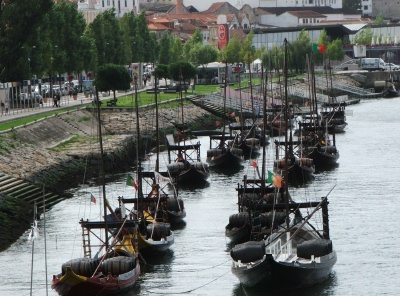
A typical scene of Oporto, Portugal
Living the Dream, part 5
Leixoěs to Madeira
Our sojourn in the marina at Leixoěs enabled us to visit the ancient city of Oporto, the centre of the world’s port trade, which we found to be like no other city we had visited before, in architecture, ambience, originality and splendour. We visited Calem, one of the many port lodges (Sandeman, Warre, Dow, Taylor, etc.) and after a conducted tour tasted a couple of their excellent products. With all the wealth held in the port lodges of the city, we were surprised that many of the tall dwelling houses almost fronting the famous river were virtually derelict and an injection of EU or port cash is certainly needed to restore it to its medieval glory.
We met a very friendly couple called Paul and Rosie, in their beautiful Nicholson 32, "Barada". Over a relaxed meal aboard LB, we swapped adventure stories and told of our sailing plans for the future. That meal was eaten while a gale howled outside. That same night just on the other side of the harbour wall, a Spanish yacht foundered on the beach and was smashed to pieces with the loss of both persons on board.
Rosie was recuperating from a slip in the cockpit, which left her leg in bandages, but she managed to hobble with Siobhan to the shops, which were some distance away. While in Leixoěs, we walked around the port road and visited the very extensive fish and vegetable market and lunched on fried sardines and lemon sole followed by "Porco a alentejana" (pork with clams served with squared fried potatoes). This was a local speciality and it is well worth learning Portuguese to avoid what one doesn’t like on the menu. It’s no use knowing French and Spanish, because the similarity of Romantic vocabulary doesn’t work all the time.
It was during this period that I returned to Plymouth for the funeral of my nephew, Gregory. I found the whole service and wake naturally very distressing, as we are a close family, despite our distances from each other. When I returned, I wanted to get back to sea and attempt to clear my head of sad thoughts, while still having happy memories of Greg. Soon after, we set off south, intending to try and outrun the bad weather, which had been dogging our footsteps since leaving Ireland. We had planned to continue as far south along the Portuguese coast until we encountered the annual north-easterly winds, which would carry us across the 450 miles to Porto Santo.
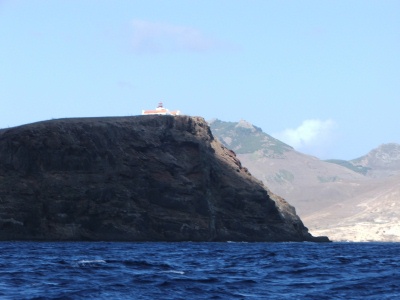
Punta de Sagres
We turned east at a benign Cape St Vincent and en route, at Punta de Sagres, where the cliff soars to a height of 100 feet (30 m), we were surprised to see a number of men fishing from the top of the cliff, defying gravity, vertigo and obviously beating the height record for fishing. (We did not see them catch anything.) Later we saw a flock of Pomarine Skuas, sitting together on the water, which was another first for us, as fledgling twitchers.
We anchored just outside Lagos marina in finally awaited sunshine, but the following morning, awoke to thick fog, with visibility down to 100 metres, which soon lifted bathing us again in brilliant sunshine. We waited until we received good weather forecasts indicating a settled northerly airstream and on 12 October 2006 at 0830 hours, we set off on our next major passage, towards Porto Santo. With 450 miles to cover, I estimated that it would take us between 4 to 5 days and looked forward to a straightforward voyage. How wrong I was to be!
We set sail on a beautifully clear day, initially with only 4 to 5 knots of wind. Soon we were down to 0.8 knots of wind. However, as we cleared Cape St Vincent the wind arrived with 8 to 11 knots from the north and by 1245 we had 17 knots. The first 24 hour mileage was 132 sea miles. The northerlies continued for the next 24 hours and we covered 94 miles and the third day 84 miles., but then I have written in the log, "Virtually becalmed. Wind all round the compass, sea a deep purple colour. With the horizon at 360°, its like being on top of the world. As it is so calm I have fitted the triple belt on the water maker and will run it for 3 hours….. It is a perfectly wonderful day with the sun shining out of an azure sky with just a few fluffy clouds to break the monotony. We have seen no boats and no dolphins for several days and no birds for at least 2 days. A lifeless void and we are in the centre of it."
The wind then moved around to the south-west but still only Force 1. We spotted two small turtles (6-12 inches long) swimming in the open ocean. Other cruising people to whom we spoke had seen many of them. After this relaxed period, we were destined for a prolonged stage of frustration in our voyage, in which we thought it would take days to reach Porto Santo and we couldn’t have been more right. I have written in the log, "A very tiring and frustrating 24 hours as we have been headed by south westerlies, which brought torrential rain and high winds ( 27 knots) — we had put two reefs in the main and reduced the working jib by a third — this had levelled things off. Flaked them out this morning, but the wind is now from the west and light. A current is however heading us south. This morning we were surprised by a pod of Pilot whales, which swam beside us for a good hour. Very calm and sedate creatures. When I first saw one, I jumped as it was about 10 feet long."
During this period the weather was very unsettled and changed to the west, so we changed course to try and utilise it.
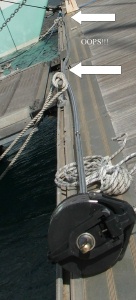
At 0030 hours on 16 October 2006, we were sailing in 17 knots of south-westerly wind when the working jib and furling foil detached themselves from the mast entirely. Luckily (bearing in mind that it was pitch black and the heavy swell from the north-west was still prevalent) I managed to lay it along the port deck, although it stretched out over the stern by some 10 feet. I secured it to the toe rail and wrapped the sail around it as well as possible. The wind rose to 21 knots. We could not use the lightweight genoa as it only carries to about 11 knots when beating and is not a reefing sail. The swell was such that I could not safely take off the lightweight genoa and replace it with our spare working jib. This left us with the mainsail with two reefs in it. Thus began two and a half days of misery.
Siobhan wrote, "During the night we had a number of gusts (maximum 38 knots. Wind speed averaged 21-22 knots. Around 0830, the jib which was tied to the deck started trailing in the sea and filling up with water. Lawry lowered a rope around the sail and hoisted it with a halyard. This successfully emptied the water out. Very frustrating day. Very high swell (four and a half metres)."
The sack of water was as big as a baby hippo and although I tried, I could not raise or upset its contents by hand. With the sea state so unsettled with south-westerly winds and a large north-westerly swell, which had been with us since Hurricane “Gordon”, it was very difficult to maintain any balance on the port side deck. Needless to say, I was hanked on and when we lassoed the hippo water bag, Siobhan was at the mast as well, well hanked on and turning the spinnaker winch. We cheered when the water was spilled out and equilibrium was restored.
We had to press on then with the main with 2 reefs and the engine running at 2000 rpm. At the time we were in between two large sea mounts and were long distance tacking to avoid them, while trying not to be sent too far south past Porto Santo.
To cap it all, at 1630 hours on 17 October 2006, the ST 7000 autohelm failed and so from then on we had no navigation instruments other than the ship’s compass, a hand-held GPS and our Inmarsat (what more do you need?). I examined the compass computer box of the ST 7000 and found that water had been dripping down from the steering pod and that it was damp and covered in water droplets. This was the same instrument box, which had been drenched by the cracked compression joint of the water maker. I dried it all off and placed a plastic box lid over the top of it to deflect water, but it still did not work and as I write this in Porto Santo on 25 October 2006, it still registers "ST 7000 fail".
As a change from our normal 3 hour sleep/watch pattern, on the last night, we had one hour about and managed to navigate “Light Blue” to Porto Santo finally arriving at 1330 hours on 18 October 2006, six and a half days after leaving Lagos. We anchored in the harbour after sailing the last 10 miles in pleasant weather. We had not been in survival conditions, but for the previous 60 hours our smooth sailing machine had operated in a less than efficient way and we had entered a state, whereby we were monitoring the boat and our condition along from one hour to the next. We did not turn back because we were three-quarters of the way there and the boat was sound, we had a strong engine and at least the main sail. Conditions weren’t that severe that we could not see an end to the striving to reach Porto Santo.
Despite the fact that we wanted to sleep and then register with the authorities the following day, my call to the marina emphasised that we should register on the date of arrival, so we dug out the dinghy from the cockpit locker, started up the outboard and motored ashore to be greeted by the friendliest marina manager, Sonia and the police/ immigration official made us feel very welcome. Moreover, Nelson, the ever cooperative marina supervisor helped us to tie up “Light Blue” in the marina, where we spent the next 10 days, resting, recuperating and waiting for a new “T” bracket for the inner forestay foil. Furthermore, we met so many friendly cruisers, who had been in similar situations and appreciated what we had been through.
There was Richard and Ailish, and their son Matthew, Declan and Debbie with their two children Saoirse and Donacha. There was Peter and Sue, who had already passed this way before and Gerry, who, at the age of 72 years, believed he was on his last trip (he was heading for Brazil single handed). It was interesting to note that all their boats were steel, except for Declan’s, which was a sturdily built 1970 GRP of classic lines, which looked as strong as steel. In fact the group of yachts on the pontoon were of a different make-up to those one would see in a UK marina, as they were clearly ocean-going craft.
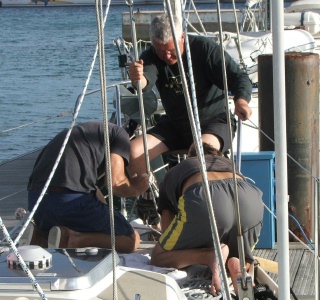
Repairs to damage
During our stay, all these cruising people volunteered to assist us in the removal of the inner forestay foil and sail, gave invaluable advice and eventually assisted us to re-rig Light Blue. To hook the forestay back on, I had to release the back stays completely and then we had to crank the foil onto its clevis pin at the bow by means of a Spanish windlass. We had many communal meals with various parts of the group and on our final evening, we laid on a thank you supper of curry, beers and wine, to which everyone participated. The children made a wonderful chocolate cake, which meant they had to learn the Portuguese words for the ingredients, which was highly commendable and tasty.
Waiting for the rigging part left us time to explore this mid-Atlantic island, which resembled a desert in places and a quarry in other locations. We took in the island by open-top bus, which took us to several spectacular sites with beautiful sights. A daily walk to the town and back kept us fit and healthy and visits to the town’s internet café kept us abreast of news from friends and family. The weather played its part in our waiting, but eventually we cast off and set sail for Madeira, a mere 20 odd miles away, which we covered reasonably quickly without hassle despite having only a spitfire jib flying (as the wind was too strong for the lightweight genoa and we still had to get the working jib repaired in Madeira).
We sailed into Quinta do Lorde marina and were met by the ebullient Orlando, who made us feel very welcome and helped us to tie up beside Richard and Ailish’s yacht, which had arrived at the same time as us. During the following week, we shared a hire car for three days, which gave us the opportunity of seeing a great deal of the island of Madeira, with its dramatic scenery, in stark contrast to her sister island of Porto Santo. We were all impressed by the modern roads, the tunnelling infrastructure throughout the island (some of the tunnels were several kilometres long, running straight through mountains).
Funchal
The city of Funchal is a mixture of grandiose splendour from ages past cheek-by-jowl with modern tastefully designed buildings. We were unenthusiastic about the city marina, which looked crowded, with the ocean cruisers rafted up several deep on the harbour wall. The boats in the anchorage outside wallowed uncomfortably. We had decided that we would not be transferring to this marina for those reasons, even though the one-hour bus ride from our marina to Funchal and the wait for the return bus was sometimes trying on the patience. The bus rides were similar to the white-knuckle rides at Alton Towers in England, with death-defying sudden drops in altitude, sweeps around hairpin bends, hovering over the cliff edge and sudden braking motion at the bus stops. The drivers slung the large single decker buses around as if they were sports cars and passed other vehicles at narrow sections with inches to spare. It was for me a white-knuckle ride and a relief to arrive safely.
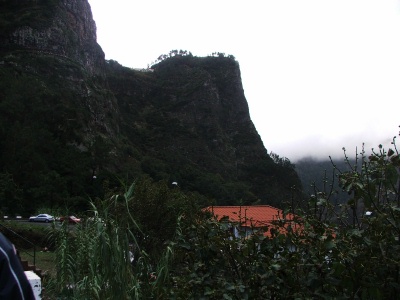
During our tour of the island we visited a village in the heart of the island called Curral das Frieras, where they were having an annual chestnut festival. We tried the cold and hot chestnuts, the chestnut cake, the chestnut liquor and shared a whole barbecued chicken between us as we were walking through the fair. It was a feast of different tastes, smells, sights and experiences. It had been worth the hour-long hairpin drive there and back. Rain had been pouring for a long time up in the mountains and there were signs of landslides and in fact on the way back we were held up for half an hour while the necessary authorities removed a tree blocking our road, which had also brought down a telegraph pole and threatened a hillside villa.
We had the sail repaired at a reasonable price and with the minimum amount of bother by Eric, a South African, who had settled in Madeira with his wife after several years of cruising. It was very pleasant to meet them and see the life that they had carved for themselves in retirement from cruising. We also purchased two new lengths of reefing line (55 metres in all) and Siobhan and I spent the good part of half a day removing the end of the boom by drilling out the pop rivets, then cleaning out the birds nests from among the remaining ropes and wire cable and finally replacing the broken red second reefing line and the third green line, which was still intact, but I didn’t want to take a chance on that breaking unexpectedly like the red.
With the boat now repaired, we have filled up her with water and diesel, today we have only to re-provision with food and replace our propane gas cylinders and we are ready to go again. We are intent on sailing tomorrow for the Canaries and will plan to landfall on Graciosa in about three days. So for now we will say Ate Logo (see you later) and keep reading.
Lawry and Siobhán Nunn (L.T.D), 6 November 2006
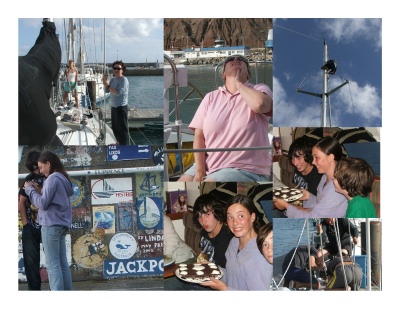
New friends and another good souvenir
